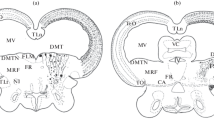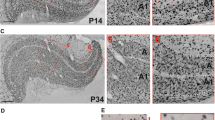Summary
The ontogenetical development of the subcommissural organ (SCO) was investigated in chick embryos collected daily from the 1st to the 21st day of incubation. Some duck embryos, and adult chickens and ducks were also studied. Immunocytochemistry using an anti-Reissner's fiber (RF) serum as the primary antibody was the principal method used.
In the chick embryos the events occurring at different days of incubation were: day 3 morphologically undifferentiated cells in the dorsal diencephalon displayed immunoreactive material (IRM); days 4 to 6 immunoreactive cells proliferated, formed a multilayered structure and developed processes which traversed the growing posterior commissure and ended at the brain surface; day 7 i) blood vessels penetrated the SCO, ii) scarce hypendymal cells appeared, iii) the first signs of ventricular release of IRM were noticed, iv) appearance of IRM bound to cells of the floor of the Sylvius aqueduct; day 7 to 10 the number of apical granules and amount of extracellular IRM increased progressively; day 11 RF was observed along the Sylvian aqueduct; day 12 RF was present in the lumbar spinal cord; day 13 IRM on the aqueductal floor disappeared; days 10 to 21 i) hypendymal cells proliferated, developed processes and migrated dorsally, ii) ependymal processes elongated and their endings covered the external limiting membrane. In adult specimens the ependymal cells lacked basal processes and the external membrane was contacted by hypendymal cells. The duck SCO appears to follow a similar pattern of development.
Similar content being viewed by others
References
Altner H (1963) Histologische Untersuchungen am Saccus vasculosus der Knorpelfische. Z Mikrosk Anat Forsch 70:1–9
Ermisch A, Sterba G, Mueller A, Hess J (1971) Autoradiographische Untersuchungen am Subcommisuralorgan und dem Reissnerschen Faden. I. Organsekretion und Parameter der Organleistung als Grundlagen zur Beurteilung der Organfunktion. Acta Zool 52:1–21
Ermisch H (1973) Zur Charakterisierung des Komplexes Subcommissuralorgan-Reissnerscher Faden und seiner Beziehung zum Liquor unter besonderer Berücksichtigung autoradiographischer Untersuchungen sowie funktioneller Aspekte. Wiss Z Karl-Marx-Univ Leipzig Mat Naturwiss R 22:297–336
Gabe M (1968) Techniques histologiques. Masson, Paris
Hamilton HL (1965) Outline of development, orientation, chronology. In: Lillie's development of the chick. An introduction to embryology. Holt, Rinehart and Winston, New York, pp 70–91
Kimble JE, Møllgard K (1975) Subcommissural organ-associated neurons in fetal and neonatal rabbit. Cell Tissue Res 159:195–204
Köhl W, Linderer Th (1973) Zur Entwicklung des Subcommissuralorgans der Ratte. Morphologische und histochemische Untersuchungen. Histochemie 33:349–368
Marcinkiewicz M, Bouchaud C (1983) The ependymal secretion of the fetal and adult rat subcommissural organ. Morphological aspects linked to the synthesis, storage and release of the secretory products. Biol Cell 48:47–52
Møllgard K (1972) Histochemical investigations on the human foetal subcommissural organ. I. Carbohydrates and mucosubstances, proteins and nucleoproteins, esterase, acid and alkaline phosphatase. Histochemie 32:31–48
Oksche A (1956) Funktionelle histologische Untersuchungen über die Organe des Zwischenhirndaches der Chordaten. Anat Anz 102:204–419
Oksche A (1961) Vergleichende Untersuchungen über die sekretorische Aktivität des Subkommisuralorgans und der Gliacharakter seiner Zellen. Z Zellforsch 54:549–612
Olsson R (1956) The development of Reissner's fibre in the brain of the salmon. Acta Zool (Stockh) 37:235–250
Olsson R (1961) Subcommissural ependyma and pineal organ development in human fetuses. Gen Comp Endocrinol 1:117–123
Rodríguez EM, Yulis R, Peruzzo B, Alvial G, Andrade R (1984a) Standardization of various applications of methacrylate embedding and silver methenamine for light and electron microscopy immunocytochemistry. Histochemistry 81:253–263
Rodríguez EM, Oksche A, Hein S, Rodríguez S, Yulis R (1984b) Comparative immunocytochemical study of the subcommissural organ. Cell Tissue Res 237:427–441
Rodríguez EM, Oksche A, Hein S, Rodríguez S, Yulis R (1984c) Spatial and structural interrelationships between secretory cells of the subcommissural organ and blood vessels. An immunocytochemical study. Cell Tissue Res 237:443–449
Rodríguez EM, Herrera A, Peruzzo B, Rodríguez S, Hein S, Oksche A (1986) Light and electron microscopic lectin histochemistry and immunohistochemistry of the subcommissural organ: evidence for processing of the secretory material. Cell Tissue Res 243:545–559
Sofroniew MV, Weindl A, Schinko I, Wetzstein R (1979) The distribution of vasopressin-, oxytocin- and neurophysin-producing neurons in the guinea pig brain; I. The classical hypothalamoneurohypophyseal system. Cell Tissue Res 196:367–384
Sterba G, Müller H, Naumann W (1967) Fluoreszenz- und elektronenmikroskopische Untersuchungen über die Bildung des Reissnerschen Fadens bei Lampetra planeri (Bloch). Z Zellforsch 76:355–376
Sterba G, Kießig C, Naumann W, Petter H, Kleim I (1982) The secretion of the subcommissural organ. A comparative immunocytochemical investigation. Cell Tissue Res 226:427–439
Sternberger LA, Hardy PH, Jr Cuculis JJ, Meyer HG (1970) The unlabeled antibody enzyme method of immunohistochemistry; Preparation of properties of soluble antigen-antibody complex (horseradish peroxidase-antiperoxidase) and its use in identification of spirochetes. J Histochem Cytochem 18:315–333
Vogt H (1979) (Hrsg): Jahrbuch für die Geflügelwirtschaft 1980. Stuttgart: Ulmer
Wingstrand KG (1953) Neurosecretion and antidiuretic activity in chick embryos with remarks on the subcommissural organ. Ark Zool (Stockh) 6:41–67
Wislocki GB, Roth WD (1958) Selective staining of the human subcommissural organ. Anat Rec 130:125–130
Ziegels J (1977) Etude histochemique de l'organe sous-commissural du poulet au cours du développement. CR Soc Biol 171:1306–1308
Author information
Authors and Affiliations
Additional information
Supported by Grant I/60 935 from the Stiftung Volkswagenwerk, Federal Republic of Germany, and Grant RS-82-18 from the Dirección de Investigaciones, Universidad Austral de Chile. M.H. was recipient of a personal grant from JNO (29-5-54), which is gratefully acknowledged
Rights and permissions
About this article
Cite this article
Schoebitz, K., Garrido, O., Heinrichs, M. et al. Ontogenetical development of the chick and duck subcommissural organ. Histochemistry 84, 31–40 (1986). https://doi.org/10.1007/BF00493417
Accepted:
Issue Date:
DOI: https://doi.org/10.1007/BF00493417




